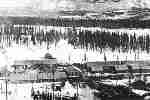
|
Otter Internment Camp. Yoho National Park, B.C. (Photo courtesy of the National Archives of Canada, C81374) |
They are a forgotten chapter in Canada's history and indeed represent a black mark on our human rights record. They were the first innocent victims of the War Measures Act that was later to tyrannize Japanese-Canadians in 1940 and Quebecois in 1970.
And Kingston's Fort Henry played a major role in a drama which saw Canadian citizens placed in internment camps, have their possessions confiscated, and lose their right to vote, all because their native country had been conquered by another at war with Canada.
Twenty years ago Montreal director Yurij Luhovy first heard of the plight of the 5,000 Ukrainians who were interned in 24 prison camps across Canada during the First World War and decided to make a film about it. He began working in earnest four years ago and after struggling to get the $300,000 to make it, has finally completed Freedom Had A Price, a one-hour documentary which is having screenings across Canada. It will probably be screened at Fort Henry some time in August.
And what's the fort got to do with this? It was the first internment camp in Canada for German prisoners-of-war and the "enemy aliens," most of whom were Ukrainians. It's not that only local star in the film though. There's vintage film of Kingston's waterfront, plus interviews with the fort's curator Stephen Mecredy, Royal Military College professor Lubomyr Luciuk, and Victor Brightman who was a guard both at the fort and later at the largest camp in Kapuskasing.
Freedom Had A Price pulls no punches in finding fault with the Canadian government's handling of the affair. It points out that Ukrainians were invited to this country as settlers starting in 1896 but that by 1914 with a mini-depression on its hands, internment camps were one way of getting a lot of unemployed "foreigners" off the street. And it shows that Canada continued to intern Ukrainians and others even when they received a memo from London, advising that they were not to be considered "enemy aliens." (At the time part of Ukraine had been taken over by the Austro-Hungarian Empire which was still at war with the Allied Powers).
There are few survivors still alive (only two appear in the film) and the director had trouble getting co-operation from them. "There was a stigma attached to it which still exists even for the survivors," says Luhovy. "And I lost two or three survivors at the last minute because they died."
Because of the shortage of direct testimony, the director had to rely on professors to describe many of the conditions in the internment camps, which is a major weakness of the film.
It's incongruous to have well-heeled professors in suits and well-modulated voices talk of oppressed people living in fairly primitive conditions and it certainly doesn't give much of a feel for the subject.
By the same token, when camp survivor Mary Manko-Haskett talks about having to bury a little sister there, it's hard not to be moved; as is the case when internee Nick Lypka speaks of being put in a dark hole for a couple of days because he picked up the spent shells from a guard's gun.
Still, several of those professors, including Kingston's Luciuk, generously shared their research with the director, saving him valuable time and money.
Luhovy figures he spent $100,000 of his own money on the film, which he earned by working as an editor on other projects like Kanesatake: 270 Years of Resistance. He couldn't get any government funding because of a Catch-22 situation. Neither Telefilm Canada nor the Quebec funding agency Sogic would underwrite the project without a presale agreement with the CBC. And the latter wouldn't sign a contract without seeing a rough cut of the film. Even now the CBC has resisted agreeing to air the film, although Ukrainian groups across the country have been urging the corporation to do so.
Luhovy came to Canada as a child after his parents were driven out of Ukraine by the events of the Second World War, so it's easy for him to empathize with the plight of the internees. "I like to fight for the underdog," he says, "I wanted to truth to be known because it was something I'd never read about.
"There was a moment when I was in Kapuskasing in the cemetery where 18 internees were buried and it was like their ghosts were still there. I made a promise to them then that I would make sure their story was told."
Having a Ukrainian grandmother who was living in Montreal at the time, and could have easily ended up an internee, certainly made my spine tingle when I saw the film.
![]() Return to Righting An Injustice Page
Return to Righting An Injustice Page
![]() Return to Internment of Ukrainians in Canada 1914-1920 Page
Return to Internment of Ukrainians in Canada 1914-1920 Page
![]() Return to Ukrainian History Page
Return to Ukrainian History Page
![]() Return to InfoUkes Home Page
Return to InfoUkes Home Page
Document URL: http://www.infoukes.com/history/internment/booklet02/doc-108.html
Copyright © 1994 Ukrainian Canadian Civil Liberties Association
Copyright © 1994 Lubomyr Luciuk
We acknowledge the help in the preparation of this document by Amanda Anderson
Page layout, design, integration, and maintenance by G.W. Kokodyniak and V. Pawlowsky
Copyright © 1996-1997 InfoUkes Inc.
E-mail: internment@infoukes.com
|
since Mar 1 1997 |
InfoUkes Inc. Suite 185, 3044 Bloor Street West Etobicoke, Ontario, Canada M8X 2Y8 Tel: (416) 236-4865 Fax: (416) 766-5704 |
Originally Composed: Tuesday December 3rd 1996.
Date last modified: Thursday October 30th 1997.